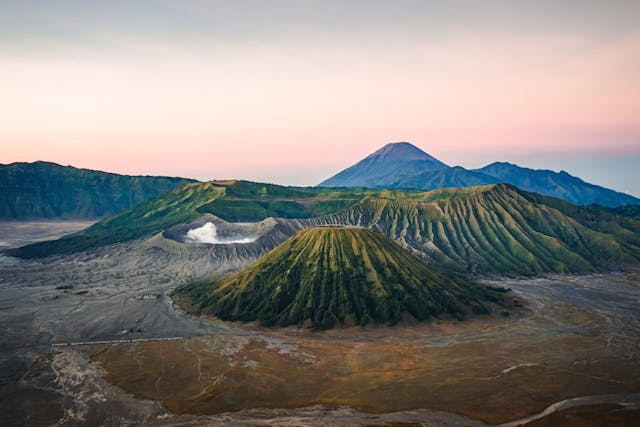
Why is there a ring of fire? The ring of fire is a ring of volcanic activity and it is caused by the tectonic plates in those areas.
The ring of fire is called that because it is an area of intense volcanic activity. The ring is 40,000 km long and it basically goes round the edge of the Pacific Ocean. It is not actually a complete ring, more of a horseshoe shape. There are a total of 450 live volcanoes and another few hundred dormant volcanoes along the ring of fire. This is 75% of all the volcanoes on Earth. There is almost constant volcanic activity and 90% of all the world’s earthquakes happen here. A lot of the volcanoes are on land, many of them are the land itself, but an awful lot of them are underwater.
The volcanoes are formed by a process called subduction. Subduction is a process whereby one tectonic plate is pushed down under another plate. The heavier and denser of the two plates is the one that is subducted. Ocean plates are denser than continental plates because of the type of rock they are made of and they are the ones that are pushed down. When ocean plates form, they are made of new, hot rock, which is lighter and rises up. As it starts to move, it cools down and becomes heavier, before it meets the continental plate and is pushed down.
When a plate is pushed down into the earth, it is a massive amount of rock and the forces are tremendous. Many of us have the image of the plates moving past each other, but they don’t move smoothly or all at once. The plates are made of rock and they jam up against each other because of friction. The plate behind the jammed section keeps moving and the force builds up, buckling the end of the plate. This deformation builds up until it is greater than the friction that is holding it. Suddenly, the force is too much and the end of the plate jerks past the other plate, getting pushed down. This enormous amount of energy is suddenly released and this is what causes earthquakes. Once the end of the plate has moved, the forces start to build up again. Tectonic plates move at about 1.5 cm a year, which is why large earthquakes don’t happen that often. It takes a lot of years for the forces to build up enough to cause a large earthquake.
The same process that produces massive earthquakes also creates volcanoes. The heavier plate that is pushed down reenters the mantle and becomes viscous again. As it goes down, it produces a deep trench at the boundary with the lighter plate. The oceanic plate is made of basalt, but it has a lot of minerals that contain water. As the oceanic plate is pushed back down into the mantle, it starts to heat up. It takes a long time to heat up because rock is not a very good conductor of heat, but once it has reached about 100 km into the earth, it has heated up enough for the water in the minerals to evaporate. The evaporated water starts to move upwards through the mantle. Once it is there, it lowers the melting temperature of the rock in the mantle above the oceanic plate and turns it into liquid magma. The liquid magma is less dense and it rises to the surface where the pressure produces a volcano. Then the pressure can slowly build up until the volcano erupts.
The ring of fire is a ring of volcanoes that go around the rim of the Pacific Ocean. The Pacific Ocean lies across several oceanic plates that are all being subducted as they meet the continental plates that surround the Pacific Ocean. Each of these boundaries of the plate are being pulled down and volcanoes form. The plates are constantly moving and being subducted, so new volcanoes are always forming. There are far more volcanoes underwater than above water and a lot of the volcanoes that we see above water are just the tips. There aren’t any volcanoes around the Atlantic Ocean because it is a different type of plate that is not being subducted. The ring of fire is a very dangerous place, but it is home to an enormous number of people. Approximately half a billion people live in the area. And this is what I learned today.
Sources
https://education.nationalgeographic.org/resource/ring-fire
https://oceanexplorer.noaa.gov/facts/rof.html
https://en.wikipedia.org/wiki/Subduction
https://www.columbia.edu/~vjd1/subd_zone_basic.htm
Photo by Rizk Nas: https://www.pexels.com/photo/green-mountain-2826351/
